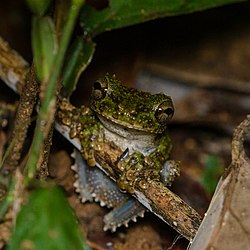Biology:Osteocephalus cabrerai
| Osteocephalus cabrerai | |
|---|---|

| |
| Scientific classification | |
| Domain: | Eukaryota |
| Kingdom: | Animalia |
| Phylum: | Chordata |
| Class: | Amphibia |
| Order: | Anura |
| Family: | Hylidae |
| Genus: | Osteocephalus |
| Species: | O. cabrerai
|
| Binomial name | |
| Osteocephalus cabrerai | |
| Synonyms[3] | |
|
Hyla cabrerai Cochran and Goin, 1970[2] | |
Osteocephalus cabrerai is a species of frog in the family Hylidae. It is found in the Amazon Basin in Brazil (Manaus), northeastern Peru, Ecuador (Sucumbíos and Orellana Provinces), Colombia (Amazonas, Caquetá, and Vaupés Departments[4]), Guyana, and French Guiana, possibly wider.[3] Some earlier records refer to Osteocephalus buckleyi.[3]
Etymology
The specific name cabrerai honours Mr. Isodore Cabrera,[2] a Colombian naturalist and collector.[5]
Description
Adult males can reach 55 mm (2.2 in) and adult females 71 mm (2.8 in) in snout–vent length. The snout is truncate.[6] The tympanum is very distinct[2] and elliptical; the supra-tympanic fold is tuberculate. Skin on the dorsum is granulate in females and tuberculate in males; these do not have keratinized tips in breeding males as in Osteocephalus buckleyi. Skin on the flanks is areolate.[6] The fingers are one-half webbed. The toes are webbed, reaching base of the disc on the fourth toe.[2] Te dorsal coloration is variable, in shades of green with tan and brown blotches, streaks, or a reticulate pattern. The flanks are light and may have tan blotches. The venter creamy is white, possibly with tan spots. A pale supralabial mark runs posteroventrally from eye to mid-tympanum. Males have paired vocal sacs.[6]
Habitat and conservation
Osteocephalus cabrerai is a lowland tropical rainforest species. Specimens have been spotted on low vegetation in primary forest or the forest edge at night. It is an uncommon species that is locally threatened by habitat loss. Its range includes a number of protected areas.[1]
References
- ↑ 1.0 1.1 Enrique La Marca, Ariadne Angulo, Luis A. Coloma, Santiago Ron (2004). "Osteocephalus cabrerai". IUCN Red List of Threatened Species 2004: e.T55790A11356745. doi:10.2305/IUCN.UK.2004.RLTS.T55790A11356745.en. https://www.iucnredlist.org/species/55790/11356745. Retrieved 16 November 2021.
- ↑ 2.0 2.1 2.2 2.3 Cochran, Doris M.; Goin, Coleman J. (1970). "Frogs of Colombia". Bulletin of the United States National Museum 288: 1–678. doi:10.5962/bhl.part.6346. https://www.biodiversitylibrary.org/item/32604. [Osteocephalus cabrerai: pp. 215–217]
- ↑ 3.0 3.1 3.2 Frost, Darrel R. (2017). "Osteocephalus cabrerai (Cochran and Goin, 1970)". Amphibian Species of the World: an Online Reference. Version 6.0. American Museum of Natural History. http://research.amnh.org/vz/herpetology/amphibia/Amphibia/Anura/Hylidae/Lophyohylinae/Osteocephalus/Osteocephalus-cabrerai.
- ↑ "Osteocephalus cabrerai (Cochran & Goin, 1970)". Lista de los Anfibios de Colombia V.07.2017.0. www.batrachia.com. 2017. http://www.batrachia.com/orden-anura/hylidae/osteocephalus-cabrerai/.
- ↑ Beolens, Bo; Watkins, Michael; Grayson, Michael (2013). The Eponym Dictionary of Amphibians. Pelagic Publishing. p. 36. ISBN 978-1-907807-42-8. https://books.google.com/books?id=ZZY3BAAAQBAJ&pg=PT36.
- ↑ 6.0 6.1 6.2 Jungfer, K.-H. (2010). "The taxonomic status of some spiny-backed treefrogs, genus Osteocephalus (Amphibia: Anura: Hylidae)". Zootaxa 2407: 28–50. doi:10.11646/zootaxa.2407.1.2. http://www.mapress.com/zootaxa/2010/2/zt02407p050.pdf.
Wikidata ☰ Q917668 entry
 |


